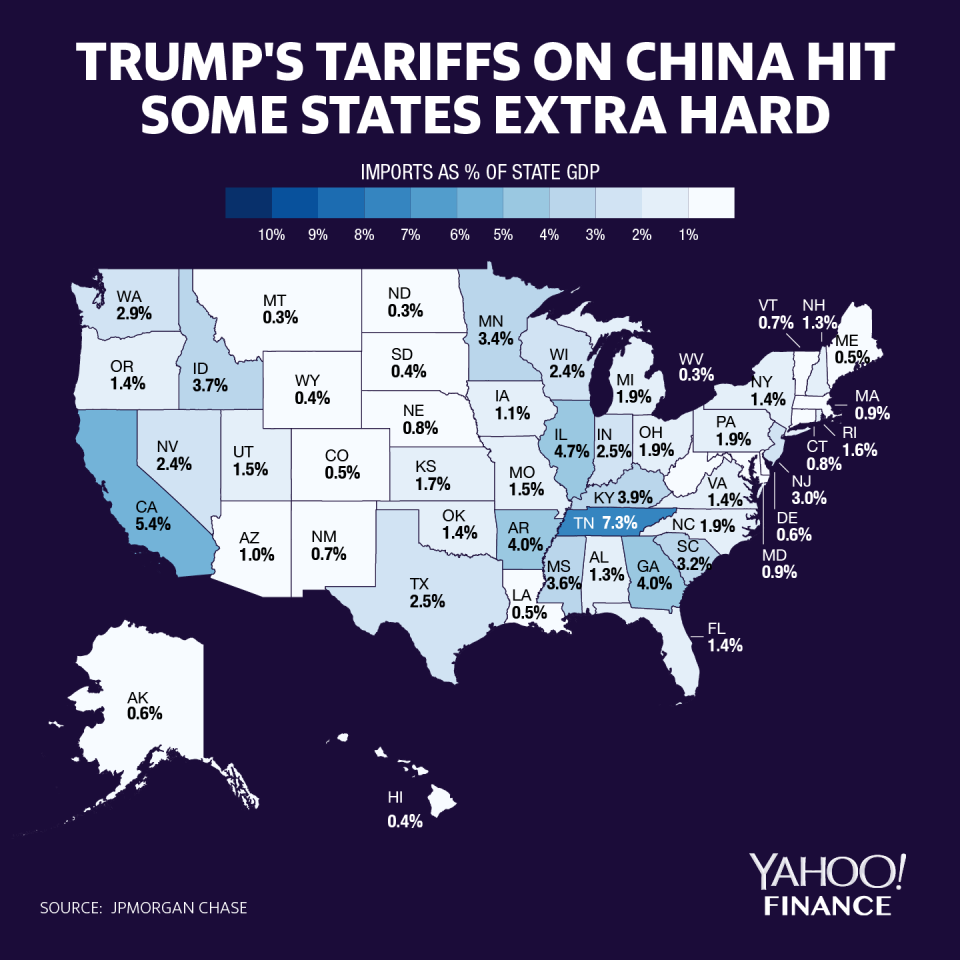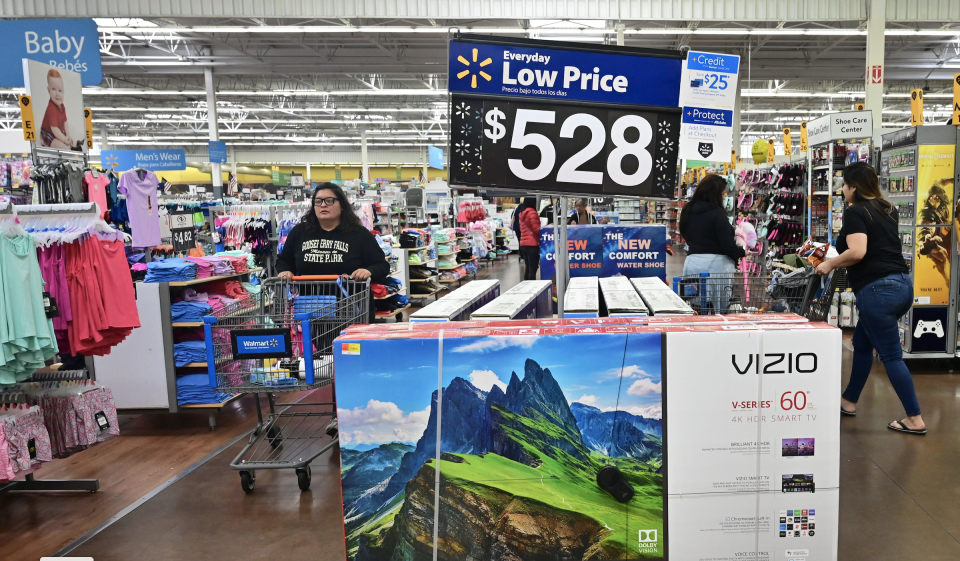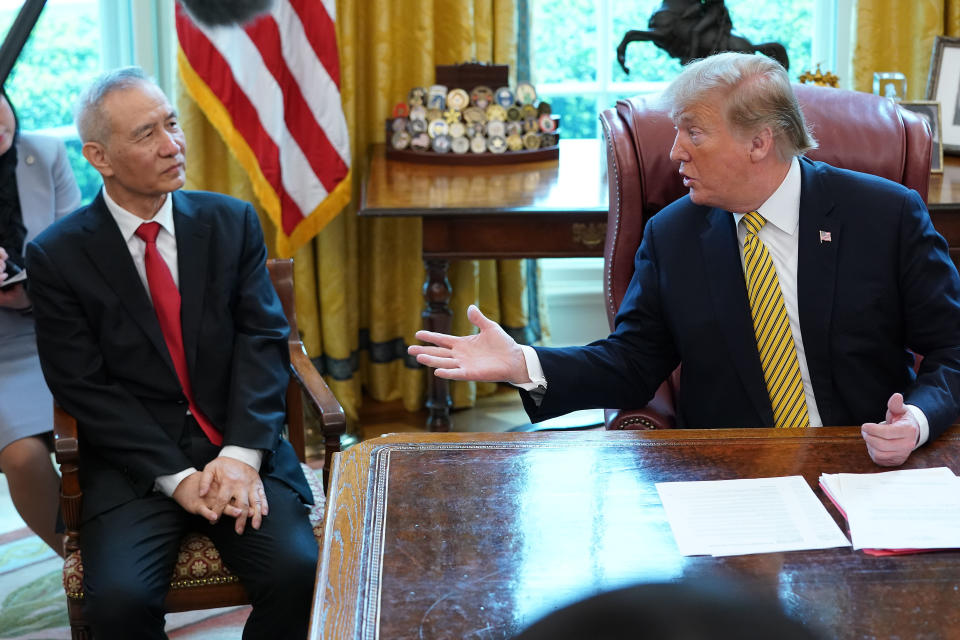These U.S. states are hit hardest by Trump's tariffs
With trade tensions between the U.S. and China rising since about March 2018, the economic effects are becoming clearer.
Following the most recent 25% tariffs on Chinese imports that Trump announced on May 10, a note from JP Morgan took a look at which states are most susceptible to this latest round.
Tennessee, Illinois, and California were the states hit the hardest when weighing imports as a percentage of state GDP, according to JP Morgan’s analysis.

“What you’ll see is what economists call an asymmetrical distribution in terms of burden sharing around the states,” RSM Chief Economist Joe Brusuelas told Yahoo Finance. In other words, some states are going to be hit harder than others by increased tariffs on Chinese goods coming into the U.S.
And while California being hit hard would seem obvious to most, Illinois and Tennessee seem unusual at first glance. Brusuelas explained that it all comes down to cheap consumer goods.
“I would assume it’s going to be a range around exposure to Walmart supply chains and Target supply chains,” he said.
Doug Barry, a spokesman for the U.S.-China Business Council, noted that the possibility of long-term damage to state economies depends on how long the new layer of tariffs continues.
“If it lasts for more than a year, for example, then the damage could be permanent,” Barry said.

Electronics was ‘by far the single-largest category’
JP Morgan listed the top goods the U.S. imports from China, which included computers and electronics, electrical equipment, manufacturing commodities, machinery, and apparel and accessories.
“In 2018, the U.S. imported $186 billion of computers and electronics from China, which was by far the single-largest category, trailed most closely by $50 billion of imports of the related electrical equipment grouping, which includes household appliances,” JP Morgan analysts noted.
Imports to Tennessee accounted for 3.4% of total U.S. imports in 2018, according to U.S. Census Bureau data. The imports included pharmaceutical products, cellular phones, passenger motor vehicles, and portable automatic data processing machines, accounted for 7.3% of the state’s GDP. Five of the top 10 companies in the state are all in the health care industry.
California’s top imports in 2018 were passenger vehicles, crude oil from petroleum and bituminous minerals, portable automatic data processing machines, phones for cellular networks, and automated data processing machines. This was unsurprising, as the state is the home of Silicon Valley where technological items are used on a daily basis. Overall, imports make up 5.4% of the state’s GDP.
Illinois’s major 2018 imports made up for 4.7% of the state’s GDP and included crude oil from petroleum and bituminous minerals, phones for cellular networks, parts of airplanes and helicopters, portable digital automated data processing machines, pharmaceutical products, and beer made from malt. Some of the biggest companies in Illinois include Walgreens pharmacy (WBA), economic bellwether Caterpillar (CAT), and United Airlines (UAL).

‘Right around the time the kids go back to school’
How this will play out for the general U.S. economy is unclear.
“There is a lot of uncertainty about what actually will happen with tariffs over time and what the economic effects will be, although in broad terms we think that higher tariffs should weigh on growth and boost inflation,” the note stated.
Greg Valliere, chief U.S. strategist at AGF, expressed a similar sentiment.
“Obviously a protracted trade war would dampen U.S. GDP growth, maybe by 0.3 or 0.4%,” he told Yahoo Finance. “The impact on business confidence is hard to quantify, although the uncertainty clearly would be a negative.”
Additionally, a potential effect that “hasn’t been explored enough is the potential for higher inflation,” Valliere said. “Since everyone seemingly has declared inflation as dead, this could be a sleeper. If tariffs cause the prices of thousands of goods to rise, even by a percentage point or two, that could have a ripple effect throughout the entire economy.”
One thing is certain, however: The most popular way for individual companies to deal with tariffs is to pass the cost increase onto customers. A recent survey of 100 business executives by the Federal Reserve Bank of Dallas found that 41 of those respondents mitigated tariffs by passing costs higher costs to customers.
And American households are already paying for the tariffs: A New York Fed study estimated that President Trump’s latest round of tariffs is likely costing American households $831 each this year. The Trade Partnership Worldwide put that number between $767 and $2,389 per family.
Brusuelas expects that consumers are going to start feeling this damage in the coming months.
“The consumer hasn’t seen much damage because it’s been all isolated in industrial products and manufacturing vis-a-vis thin margins,” Brusuelas said. “The next wave will begin to negatively impact consumers right around the time the kids go back to school, so we may have a different reaction from the public.”

U.S.-China trade war going on 15 months
The trade tensions between the Trump administration and China began in earnest in March 2018, when President Trump imposed a 25% tariff on most steel imports and a 10% tariff on most aluminum imports.
Three months later, according to China Briefing, “the U.S. Customs and Border Protection (CBP) begins collecting a 25% tariff on 818 imported Chinese products valued at $34 billion.” China responded by placing retaliatory tariffs on U.S. products.
In August 2018, the U.S. implemented its second round of tariffs on Chinese imports as 25% tariffs were placed on items like semiconductors, chemicals, motorbikes, and more.
Yet another round went into effect on Sept. 24 but a temporary truce between the two countries was reached on Dec. 2. Negotiations came to a standstill over the next few months and on May 10, 2019, the U.S. increased tariffs on $300 billion of Chinese imports to 25%.
Morgan Stanley noted that the U.S. has applied a total of $250 billion worth of tariffs on Chinese goods as of mid-June 2019.
Adriana is an associate editor for Yahoo Finance. Follow her on Twitter @adrianambells.
READ MORE:
National Retail Federation: New Trump tariffs are 'too great a gamble'
Expert: 'We are worse off as a world' amid Trump's trade war
'Is this sustainable?’: Farmers say bailouts aren’t enough in Trump’s trade war
Read the latest financial and business news from Yahoo Finance
Follow Yahoo Finance on Twitter, Facebook, Instagram, Flipboard, SmartNews, LinkedIn, YouTube, and reddit.

 Yahoo Finance
Yahoo Finance 
